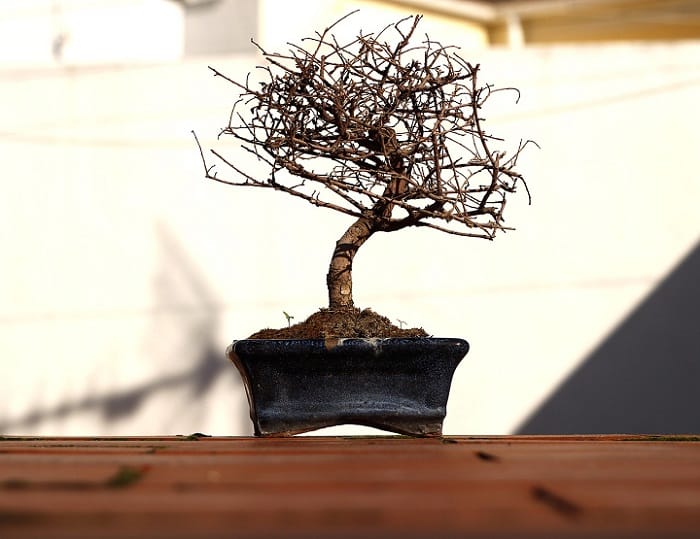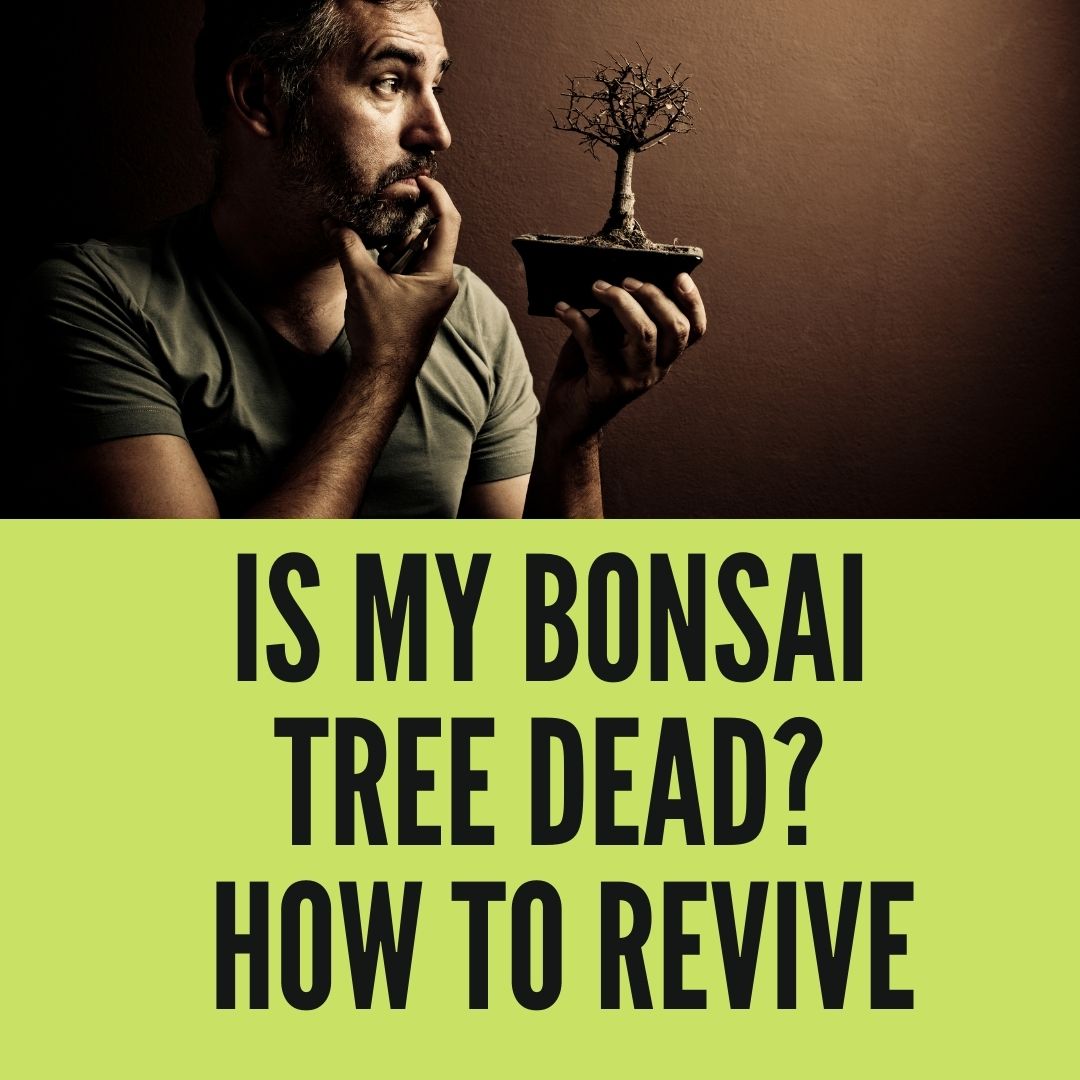Is something about your bonsai tree bothering you lately? Maybe that’s why you are reading this right now. First of all, I believe that a person who has a bonsai tree is a kind and loving person in nature because a bonsai tree needs care and attention.
If your bonsai does not look as fresh and beautiful as before, please don’t be sad. You might be thinking, is my bonsai tree dead? Sometimes things go wrong and it’s absolutely okay. And a tree does not die in one day; maybe your tree is leaving the warning sign now.
Is my Bonsai tree dead? Easy Signs
Dead Bonsai trees have brittle branches and leaves, discoloration, and fragile branches that are easily snapped or torn off if you shake them. Irregular coloring or discoloration is another way to tell that the tree may be dying or already dead. It’s also usually a sign of lack of water because the tree likely would not be able to survive with its roots too long without it. And finally, to be absolutely certain, you can cut open the bark of a branch with a knife; there should be no signs of life inside the branch of a dead tree.
If you detect these symptoms early on, then you can cure it and save your beloved bonsai.

A Dead Bonsai
How to revive a Bonsai?
When something we love gets broken or damaged, we feel immense pain and try every way to save it: be it human or any other thing. Bonsai trees need deep care and attention. It is really saddening if your bonsai tree dies.
But don’t worry, there’s a way out for saving your beloved bonsai. Well, we can’t promise you that it will revive your bonsai. Remember, not every bonsai can be saved from a dying state. But there are some steps you can follow to save it.
Here are 15 unique Bonsai ideas.
1) The reason why your bonsai is dying
First of all, you need to detect the reasons behind the dying bonsai. Normally you will see that there will be sagginess in your tree, the branches will be fragile and the tree will look like it’s drooping. The next thing you have to do is you have to cut down the withering leaves, dead or broken branches with a sharp scissor.
You have to cut the brushes till they reach the trunk of the tree. Then check if the tissues are still alive in the cutting areas of your bonsai tree. Generally, you can expect a recovery if the area looks green and healthy. You do not need to be panicked if some areas around the cut look green and fresh but others do not.
2) Check the root of Bonsai
After that change the container of your bonsai tree. While removing the tree thoroughly check the roots of Bonsai, and just like the dead branches cut down the dead roots. You need to cut down the roots until the root system. Then put the tree in a clean glass pot and fill the pot with water so that it reaches the root system.
3) Prepare another container and soil system
Meanwhile, prepare another container and soil system for the tree. Choose a sterilized container and check it thoroughly so that no germs or anything gets stuck in that pot. Then make a soil mixture with sufficient amounts of nutrients, mosses, and perlite. Make sure that the soil can receive the water and has drainage holes in it.
4) Give your Bonsai a new home
The next thing you have to do is to give your bonsai a new home. That means to fill the first half of the container with the soil, place the bonsai in it, and fill the other half with the remaining soil. Then take the container and place it in water.
5) Replace it
Take your bonsai from the water and place it in a well-conditioned place so that it gets a good development. The final thing you have to do is keep patience. You need to give your bonsai tree enough time and care to be alive again. And always remember Great Things Take Time!

What to do with a dead bonsai trees?
Bonsai trees usually have a sentimental connection with the gardener as it needs regular nurturing. When they die, it’s normal to not want to dump your dear friend in a trash bag and throw it outside.
But since it is already dead and you have no way to revive it, you have to be more creative about keeping your bonsai to yourself. Some ideas on what to with you dead bonsai-
- You can move it to a simply decorated vase to just showcase its elegant barks and twigs. Trim it to fit the vase. If you think the twigs are too delicate to stay put and will break off easily, use wires to support them
- You can use plastic flowers to decorate the tree and save it in a glass box. The boxes are pretty cheap and can be found online. You can fill up the bottom of the box with natural-looking plastic greeneries or colorful pebbles to give it a more aesthetic sight.
- If you have enough wood, you can make wood beads to make jewelry to keep a memento of your dead bonsai.
- Nowadays wood carved key -chains and pens are really on-trend. If you have a big bonsai, you can try to DIY this.
- You can cut the tree vertically and frame it to hang on the wall. There are thick custom made frames that can fit a thinly cut piece of your bonsai.
- You can also use resin to preserve your bonsai without changing its looks. This is the most effective way to keep the bonsai whole and freezing to its current state. You will find many online videos on how to preserve natural flowers and trees with resin.
Do you know why Bonsai is so expensive?
How to keep my bonsai tree alive?
Temperature: Although some people think bonsais need more temperature to survive, it actually depends on the origins of the tree you are planting. Such as-
Normal temperature: Tropical Bonsai trees need at least the temperature on standard room temperature, which is 25 degrees Celsius, The higher the temperature the better. They can survive under cold weather; even cannot face the winter wind that comes through your window.
Lower temperature: Subtropical originated bonsai trees can survive this temperature, which is not too lower from room temperature (22-23 degrees Celsius) and not really room temperature either.
Lowest temperature: When temperatures drop below the room temperature it is usually good for the Mediterranean and semitropical originated bonsai trees.
Light intensity: The light intensity needs to be higher for bonsais. Otherwise your tree’s growth will be hampered, the branches will lose their strength and fall off also leaves won’t grow either.
As you are nurturing an indoor bonsai what you can do is Place your bonsai near your window where sunlight comes in. Try to place the bonsai near a southern window. Arrange fluorescent light or light-emitting diodes for better lighting.
Air humidity: what you can do is place your bonsai where there are no air-conditioners as those bring down air humidity. Use artificial air humidifiers. You can use terrarium and other humidity keeper tools. You can spray water in the room you have placed the bonsai
Watering: Don’t water too much as the bonsai pots have little room for the water to move. You don’t want to overflow your pot as that will do more harm than reward.
Just check the mud with a stitch or toothpick to see if they are dry enough to need watering.
Fertilizers: Bonsais need fertilizers as they are limited on resources for growing in a pot. You can check out the fertilizer bonsai needs and use them from time to time.
Conclusion
It can be a difficult decision to make when you feel like your bonsai tree has died. You may have been making sure it was taken care of or had someone else take care of it, but now that the leaves are yellowing and drooping, what do you do? The good news is there’s hope for your little friend yet! In this blog post, we’ve shown how to tell if your bonsai tree is dead and what steps you might want to take next. So don’t worry; just follow these simple tips below and in no time at all your plant will be happy again!
thanks to Bonsai empire
